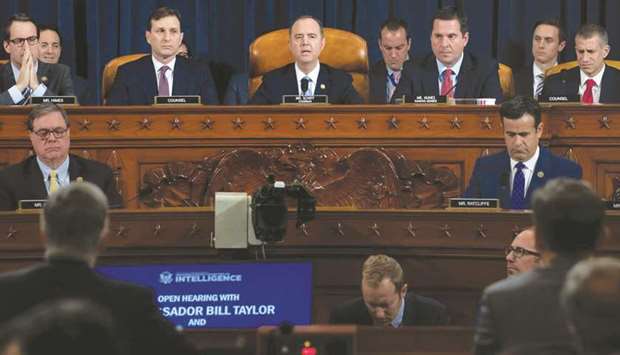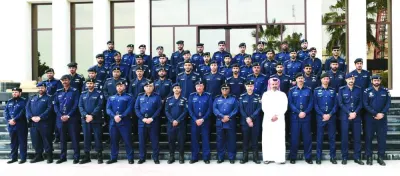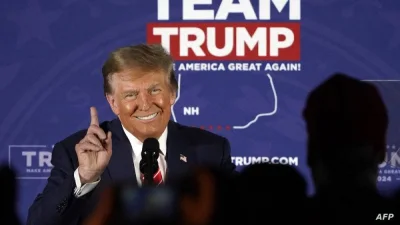Eight House Republicans working on President Donald Trump’s impeachment defence gathered in the vice-president’s suite off the Senate floor to watch the trial, taking notes and feeding suggested arguments to the president’s counsel. Four of them had expected to be among the team delivering those arguments on the floor.
Judiciary ranking member Doug Collins and members Jim Jordan, Mike Johnson and John Ratcliffe regularly met with White House Counsel Pat Cipollone late last year to prepare defense arguments. The gatherings sometimes included Trump, White House acting chief of staff Mick Mulvaney and White House senior adviser Jared Kushner, according to Johnson.
“Once it became inevitable that the impeachment would go to trial in the Senate, we began working on framing up the defense and assisting Cipollone’s team,” said Collins, R-La. “And then at one point before Christmas, we had preliminary assignments for the oral arguments and each of us were going to do a part.”
Johnson had been assigned to argue the constitutional defence, but ultimately Harvard Law School professor Alan Dershowitz was asked to present that argument after Republican senators objected to House members serving on the legal team.
“In their words they thought it would turn into a circus – as if it could have been more of a circus than it was,” Johnson said. “We’re serious lawyers. We’re experienced litigators. And we were going to treat it that way. But at the end of the day they decided to go another route, and I’m fine with that.”
For Trump’s team, there was still value in having the House Republicans involved. The members sat through witness depositions and hearings run by House Democrats, so they were intimately familiar with the evidence the impeachment managers would use in their case.
“We were the ones who carried the institutional knowledge,” Collins said. “We knew the ins and outs of the details of the case.”
While that institutional knowledge would have been useful if the four lawmakers had participated in defence arguments on the floor, Trump found another way to make use of them. The White House announced on Jan. 20 that eight House Republicans would serve on Trump’s “impeachment team” – a separate but complementary group to his team of defence lawyers.
In addition to Collins, Jordan, Johnson and Ratcliffe, Trump also choose Intelligence member Elise Stefanik and Foreign Affairs member Lee Zeldin of New York, Oversight and Reform member Mark Meadows of North Carolina and Judiciary member Debbie Lesko of Arizona to serve on the second team, which was known by a variety of shorthand names.
“I didn’t ask to participate at all. It was kind of a surprise to me,” Lesko said. “I got a text. I was at home in Arizona and I got a text from the White House.”
Johnson initially pitched Trump on the idea late in December.
“I actually talked with the president myself about the idea of having a kind of a designated group of members who would be (able) to handle the media outside the room, so to speak, outside the Senate chamber,” Johnson said.
The eight Republicans became what Collins called the “rapid response” team, tweeting real-time reaction to the trial and doing media hits during breaks. They worked closely with White House communications and legislative liaison staffers.
Having lived through the process on the House side, the eight Republicans knew when “there was a rest of the story” to some of the witness testimony that House Democrats managing the prosecution would present, Zeldin said. They’d use the breaks to provide that context to the media, while Trump’s lawyers worked on the responses they’d provide on the floor.
“In the Army, we call it ‘force multiplier,’” said Zeldin, a former military intelligence officer who still serves in the Army Reserve.
Meadows, who has since been tapped by Trump to replace Mulvaney as White House chief of staff, said the team worked in a unified way to leverage each member’s knowledge and expertise.
“We learned different strengths of our colleagues, and some of the reputations were left on the wayside,” he said. “What impressed me the most is there were a whole lot of people that were willing to be very selfless in the mission.”
Some of the eight members had worked in various capacities together previously, like the five who serve together on the Judiciary Committee. Stefanik and Zeldin are both in the New York delegation. And Meadows, Jordan and Lesko are all in the Freedom Caucus.
But other new bonds formed. Collins, Johnson and Lesko said they worked closer with Zeldin and Stefanik than they had previously in their regular House work since they don’t serve on any committees together.
Stefanik, too, said the experience allowed her to build new friendships and relationships. “You learn to respect the strengths of your colleagues,” she said.
Johnson said he and Zeldin were the two most willing to go on networks like CNN and MSNBC that tend to be more friendly to Democrats and would sometimes team up for interviews. Before Congress, Johnson served as an attorney litigating religious liberty cases, so he was used to spirited debate.
“I actually had great banter, dialogue, (during) lengthy interviews with guys like Jake Tapper and Chris Cuomo (on CNN) and Ari Melber on MSNBC and lots of those hosts that Republicans sometimes see as hostile. I actually enjoyed the banter because we had, I think, thoughtful debate and discussion about the issues.”
‘While the impeachment team members recalled some details of their experience, others had already faded a few weeks after the trial ended.
“I should have journaled all this through the whole thing,” Johnson said. “My wife told me that. She’s like, ‘You’re not going to remember all these details.’”
The Republican defense team members were not always together in the same way the seven House Democrats serving as impeachment managers were. The GOP members would gather in the vice president’s suite to watch the trial when they could, but there were usually only a handful of members there at onetime.
“The first half of it was during a recess week and people were on different schedules, so it really wasn’t until we were back in session, and even then it only happened two or three times where all eight of us were together,” Zeldin said.
Lesko would often work out of her office and head over to the Senate during breaks. “I got in a lot of steps in the tunnels,” she said, referring to the basement corridors connecting the congressional office buildings to the Capitol.
Those who were together in the suite watched the trial on big-screen TVs – sound on the stream airing the arguments and muted news channels to see how the networks were framing it – while working on their laptops.
“At one point during the oral argument – I can’t remember whose presentation it was – but we all cheered. ... One of our guys made a great point from the podium, and we are all like, ‘Yeah,’” Johnson said, cheering the word. “And the parliamentarian came in and said, ‘Keep it down in here.’” – Tribune News Service

Chairman Adam Schiff (centre), Democrat of California, gives an opening statement during the first public hearings held by the House Permanent Select Committee on Intelligence as part of the impeachment inquiry into US President Donald Trump, with witnesses Ukrainian ambassador William Taylor and Deputy Assistant Secretary George Kent testifying, on Capitol Hill in Washington, DC, US, November 13, 2019.


